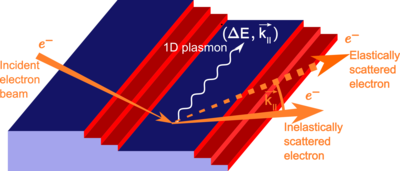Plasmon in low-dimensional structures
A prominent possiblity to couple energy transported by electromagnetic radiation into (conducting) matter is by generation of plasmons, which can happen for objects from zero to three dimensions. This rapidly growing interdisciplinary field of research is called plasmonics. One of the most attractive aspects of plasmonics is the ability to squeeze light into objects with sub-wavelength size thanks to the properties of surface plasmon polaritons (SPP). The SPP is an excitation resulting from the interaction of photons with surface plasmons. Light confinement measured by the ratio between the wavelength of the electromagnetic radiation and of the induced plasmonic excitation in the plane parallel to the surface takes place because the SPP has a group velocity that is several times lower than the speed of light. As a consequence, for any given excitation frequency, the wavelength of the SPP is shortened by the same ratio.
Even much higher in-plane confinements can be achieved with plasmons associated with two- or even with one-dimensional electronic gases. This is because their dispersion is much flatter than that of the SPP. In particular, the 2D plasmon energy, ω2DP varies as ~ √q|| for small in-plane momentum q||. For 1D a dependence ω1DP ~ q|| ln(q||) is predicted. In both cases ω2DP and ω1DP go to zero when q|| goes to zero. This allows for extraordinary light confinement from subterahertz to midinfrared frequencies by use of appropriate nanostructures providing the necessary momentum transfer.
These perspectives towards potential applications are still contrasted by a quite incomplete knowledge about the basic properties of plasmons in these low-dimensional structures. Therefore, we are carrying out studies of the plasmonic dispersion relations in selected systems both with 2D symmetry, e.g. graphene, and in strongly anisotropic 2D systems, which as a limiting case show 1D properties (a recent example is Ag/Si(557)). These studies are carried out with high resolution electron loss spectroscopy (HREELS). For this purpose an instrument is available that features both high energy and high momentum resolution.



Selected publications:
T. Lichtenstein, J. Aulbach, J. Schäfer, R. Claessen, C. Tegenkamp, H. Pfnür (2016): Two-dimensional crossover and strong coupling of plasmon excitations in arrays of one-dimensional atomic wires, Phys. Rev. B 93, 161408(R) (2016)
DOI: 10.1103/PhysRevB.93.161408
arXiv: 1601.05342
U. Krieg, T. Lichtenstein, C. Brand, C. Tegenkamp, H. Pfnür (2015): Origin of metallicity in atomic Ag wires on Si(557), New Journal of Physics, 17, 043062, 2015
DOI: 10.1088/1367-2630/17/4/043062
U. Krieg, Yu Zhang, C. Tegenkamp, H. Pfnür (2014): Tuning of one-dimensional plasmons by Ag-Doping in Ag-√3-ordered atomic wires, New J. Phys. 16, 043007 (2014)
DOI: 10.1088/1367-2630/16/4/043007
L. Vattuone, M. Smerieri, T. Langer, C. Tegenkamp, H. Pfnür, V. M. Silkin, E. V. Chulkov, P. M. Echenique, and M. Rocca (2013): Correlated Motion of Electrons on the Au(111) Surface: Anomalous Acoustic Surface-Plasmon Dispersion and Single-Particle Excitations, Phys. Rev. Lett. 110, 127405 (2013)
DOI: 10.1103/PhysRevLett.110.127405
U. Krieg, C. Brand, C. Tegenkamp, H. Pfnür (2013): One-dimensional collective excitations in Ag atomic wires grown on Si(557) , Journal of Physics: Condensed Matter 25, 014013 (2013)
DOI: 10.1088/0953-8984/25/1/014013
